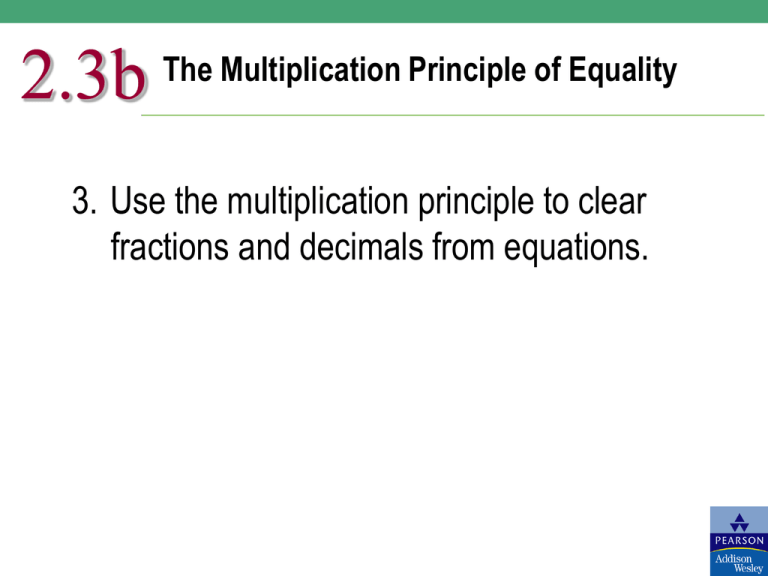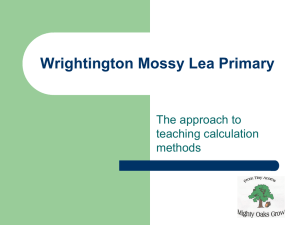Document
advertisement

2.3b The Multiplication Principle of Equality 3. Use the multiplication principle to clear fractions and decimals from equations. Review: Terms 3x 2 12 Three terms 2 2 x8 x 5 3 Three terms 2 x 3 5 9 Three terms Review: Terms 1 5 3 1 x x 3 12 4 2 Four terms 2 1 y 18 2y 3 y 3 9 3 Four terms 2 32 6 z 4z 1 18 Four terms Review 1 5 5 1 1 7 7 1 3 12 9 4 1 3 2 6 4 3 1 2 Clearing Fractions Distributive Property 5 8 13 7 7 7 1 5 1 8 5 7 7 8 13 7 7 7 1 13 7 7 7 71 71 71 5 8 13 Equivalent equation but no fractions!!! Multiply EVERY TERM by the LCD, even if the term does not contain a fraction. Only works with EQUATIONS! 5 8 6 9 Expression. Can’t clear the fractions. Clearing Fractions 2x 1 1 4 6 9 To Solve Linear Equations 1. Clear the fractions. 2. Simplify both sides of the equation as needed. a. Distribute to clear parentheses. b. Combine like terms. 3. Use the addition principle so that all variable terms are on one side of the equation. 4. Use the addition principle so that all constants are on the other side. 5. Use the multiplication principle to isolate the variable. 1. Clear fractions. 2. Simplify 3. Move the variable terms. 4. Move the constants. 5. Isolate the variable. Clearing Fractions 2x 1 1 4 6 9 LCD: 18 Terms: 3 2 1 2x 1 184 18 18 61 91 3 18 4 32 x 1 21 72 6x 3 2 6x 69 2 69 69 6x 67 6 6 67 x 6 Goal: Denominators = 1 Take the time to rewrite! Clearing Fractions LCD: 12 1 3 5 x x 2 3 4 6 Terms: 4 1. Clear fractions. 2. Simplify 3. Move the variable terms. 4. Move the constants. 5. Isolate the variable. 4 1 3 3 2 5 12 x 12 12 x 122 31 41 61 4 x 9 10 x 24 10 x 10 x 6x 9 24 9 9 6x 33 6 6 33 x 6 11 2 4 x 9 10x 24 4x 4x 9 6 x 24 1. Clear fractions. 2. Simplify 3. Move the variable terms. 4. Move the constants. 5. Isolate the variable. Clearing Fractions LCD: 10 1 3 2 y 3 y 5 y 5 10 5 Terms: 3 2 1 3 2 2 1 10 y 3 10 y 5 10 y 51 10 5 1 1 2 y 3 3 y 5 4 y 2y 6 3y 15 4y 2y 6 15 y y y 3y 6 15 6 6 3y 21 3y 21 3 3 y 7 Decimals 25 .25 100 1 .1 10 55 .055 1000 Decimals are another way to write fractions! Multiplying Powers of 10 2010 200 20100 2000 210 20 2100 200 .210 2 .2100 20 .0210 .2 Move decimal point one place. .02100 2 Move decimal point two places. Count the number of zeros and move the decimal that many places. 1. Clear fractions. 2. Simplify 3. Move the variable terms. 4. Move the constants. 5. Isolate the variable. Clearing Decimals 0.0625 0.27 x 0.304 x 6 25 27 x 30 4 x 150 27 x 304 x 150 27x 120 30x 30 x 30 x 150 3x 120 150 150 3x 30 3 3 x 10 LCD: 100 Terms: 3 Clearing Decimals 10 0.5 t 6 10.4 0.41 t 5 10 t 6 104 4 1 t 1. Clear fractions. 2. Simplify 3. Move the variable terms. 4. Move the constants. 5. Isolate the variable. LCD: 10 Terms: 4 5 10t 60 104 4 4t 10t 65 100 4t 4t 4t 14t 65 100 65 If the problem starts with decimals, leave the answer in decimal form. 65 14t 35 14 14 35 5 t 2.5 14 2 Solve. 0.8 – 4(a – 1) = 0.2 + 3(4 – a) a) 10 b) 7.4 c) 8.6 d) 20.6 2.3 Solve. 0.8 – 4(a – 1) = 0.2 + 3(4 – a) a) 10 b) 7.4 c) 8.6 d) 20.6 2.3








